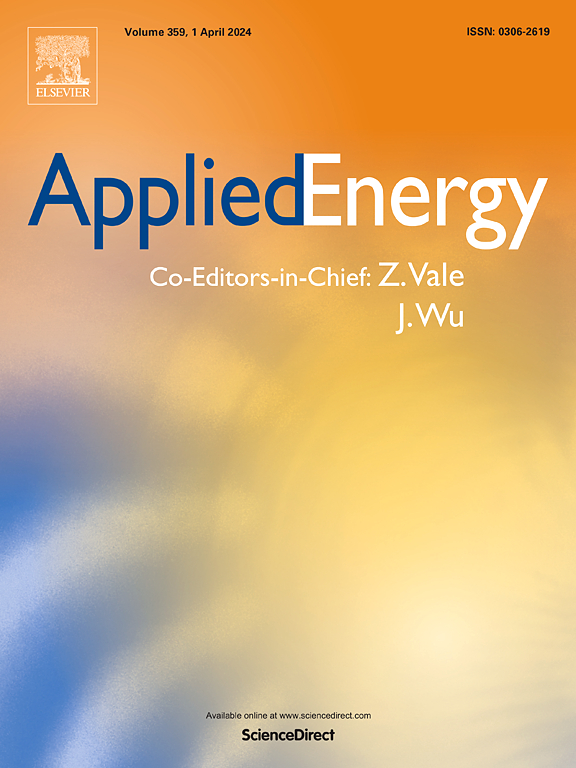波浪- wec农场相互作用的动态耦合策略:对区域波浪气候和波浪能部署的影响
IF 11
1区 工程技术
Q1 ENERGY & FUELS
引用次数: 0
摘要
通过波浪能量转换器(WEC)农场利用海浪能量为海洋可再生能源的部署提供了一条有前途的途径。然而,准确模拟WEC阵列与波场之间的相互作用仍然是一个关键的挑战,特别是在评估能量提取对波浪气候和海岸过程的影响方面。本研究提出了一种新的频谱风波模型耦合方法,以准确模拟海浪与WEC农场之间的动态相互作用,并考虑了功率起飞(PTO)效应。该方法通过两种不同但互补的策略实现了由WEC阵列引起的波能衰减的高保真建模:(1)基于捕获宽度的频域公式,以及(2)使用器件速度和PTO力/阻抗的时域表示。本文开发了一种鲁棒的数值算法来实现这些方法在频谱风波模型III (WWMIII)内的非结构化三角形网格上。经过各种波浪条件的严格验证后,该模型被应用于调查WEC农场对苏格兰西奥克尼水域波浪能资源的影响。结果揭示了波浪功率和光谱特征的时空变化。具体来说,采用时域方法的模拟结果显示,养殖场内显著高度的局部降低了1.2米,在Brough Head附近的海湾口降低了0.1米~ 0.2米。由于超谐波的明显衰减,光谱表现出明显的峰性。本模型为评估低碳农场绩效及其对环境的影响提供了一个有用的工具。这项工作为pto集成波场模拟提供了一种替代现有模型(例如SNL-SWAN)的方法,同时启动了将相位平均谱波模型与最先进的时域波结构相互作用(WSI)模型耦合的新研究,从而推动了该领域的发展。通过使PTO动力学更真实的表示,拟议的框架支持改进波浪能提取效率及其对海洋环境的影响的预测,有助于可持续的海洋可再生能源部署。本文章由计算机程序翻译,如有差异,请以英文原文为准。
A dynamic coupling strategy for wave-WEC farm interactions: Implications on regional wave climate and wave energy deployment
Harnessing ocean wave energy through Wave Energy Converter (WEC) farms presents a promising pathway for ocean renewable deployment. Yet, accurately modelling the interactions between WEC arrays and the wave field remains a critical challenge, particularly in assessing energy extraction effects on wave climate and coastal processes. This study presents a novel coupling methodology for spectral wind wave models to accurately simulate the dynamic interactions between ocean waves and WEC farms, incorporating Power Take-Off (PTO) effects. The proposed approach enables high-fidelity modelling of wave energy attenuation induced by WEC arrays through two distinct yet complementary strategies: (1) a frequency-domain formulation based on capture width, and (2) a time-domain representation using device velocities and PTO forces/impedance. A robust numerical algorithm has been developed to implement these methods on unstructured triangular grids within the spectral Wind Wave Model III (WWMIII). After rigorous verifications across a variety of wave conditions, the model is applied to investigate the impacts of WEC farms on wave power resources in the waters off west Orkney, Scotland. The results reveal valuable insights into spatiotemporal variations in wave power and spectral characteristics. Specifically, the simulation results by adopting the time-domain approach revealed a 1.2 m localized reduction of significant height within the farm and a 0.1 m ∼ 0.2 m reduction at the mouth of the bay near Brough Head. The spectra exhibited a distinct peakedness due to the pronounced attenuation of super-harmonics. The present model offers a useful tool for assessing WEC farm performance as well as their environmental impacts. This work advances the field by providing an alternative approach to the family of existing models (e.g., SNL-SWAN) for PTO-integrated wave farm simulations while initiating new research on coupling phase-averaged spectral wave models with the state-of-the-art time-domain Wave Structure Interaction (WSI) models. By enabling a more realistic representation of PTO dynamics, the proposed framework supports improved forecasting of wave energy extraction efficiency and its effects on marine environments, contributing to sustainable ocean renewable deployment.
求助全文
通过发布文献求助,成功后即可免费获取论文全文。
去求助
来源期刊

Applied Energy
工程技术-工程:化工
CiteScore
21.20
自引率
10.70%
发文量
1830
审稿时长
41 days
期刊介绍:
Applied Energy serves as a platform for sharing innovations, research, development, and demonstrations in energy conversion, conservation, and sustainable energy systems. The journal covers topics such as optimal energy resource use, environmental pollutant mitigation, and energy process analysis. It welcomes original papers, review articles, technical notes, and letters to the editor. Authors are encouraged to submit manuscripts that bridge the gap between research, development, and implementation. The journal addresses a wide spectrum of topics, including fossil and renewable energy technologies, energy economics, and environmental impacts. Applied Energy also explores modeling and forecasting, conservation strategies, and the social and economic implications of energy policies, including climate change mitigation. It is complemented by the open-access journal Advances in Applied Energy.
 求助内容:
求助内容: 应助结果提醒方式:
应助结果提醒方式:


